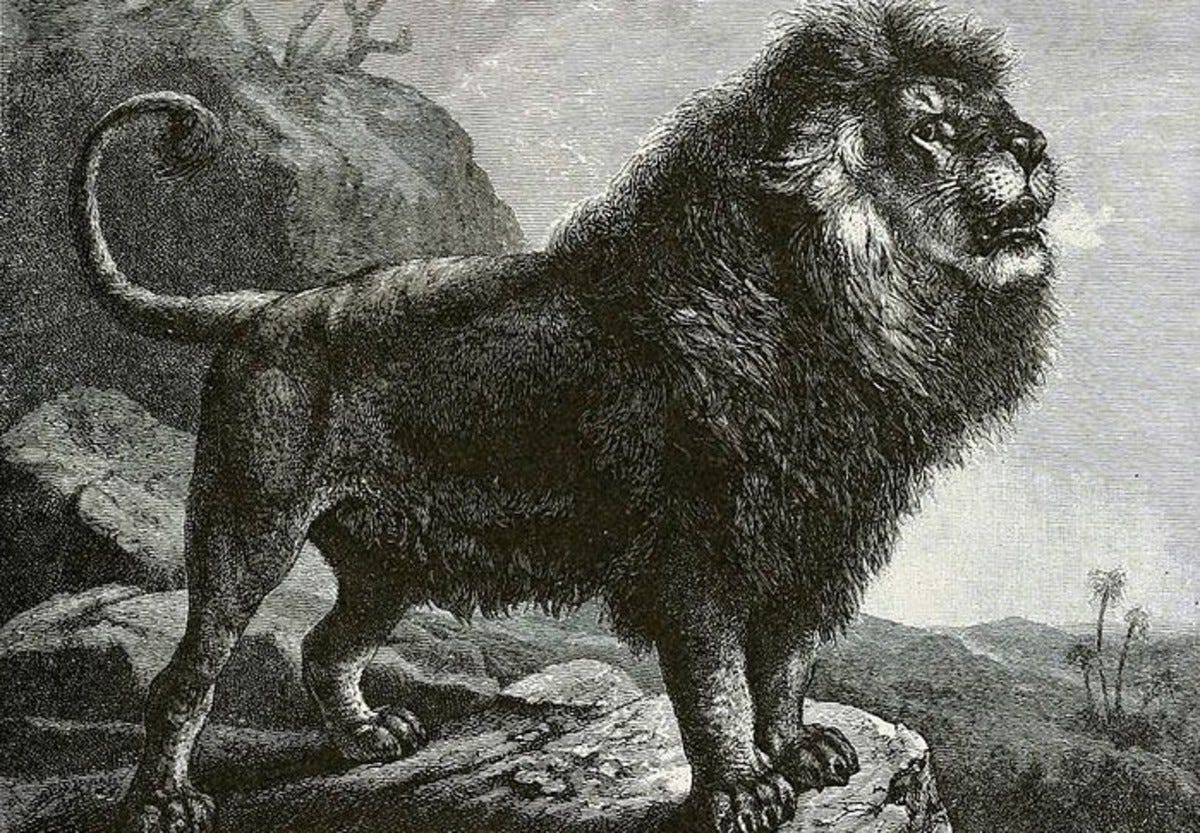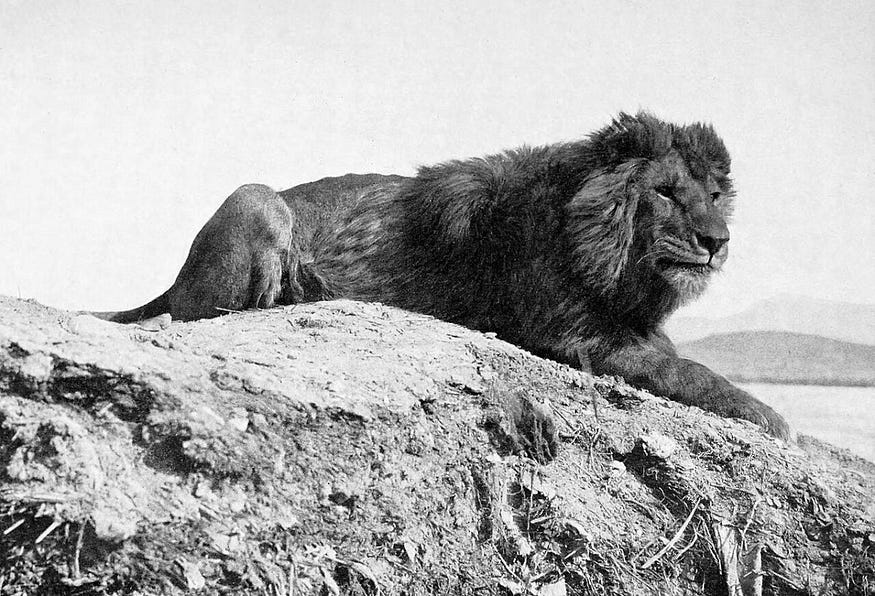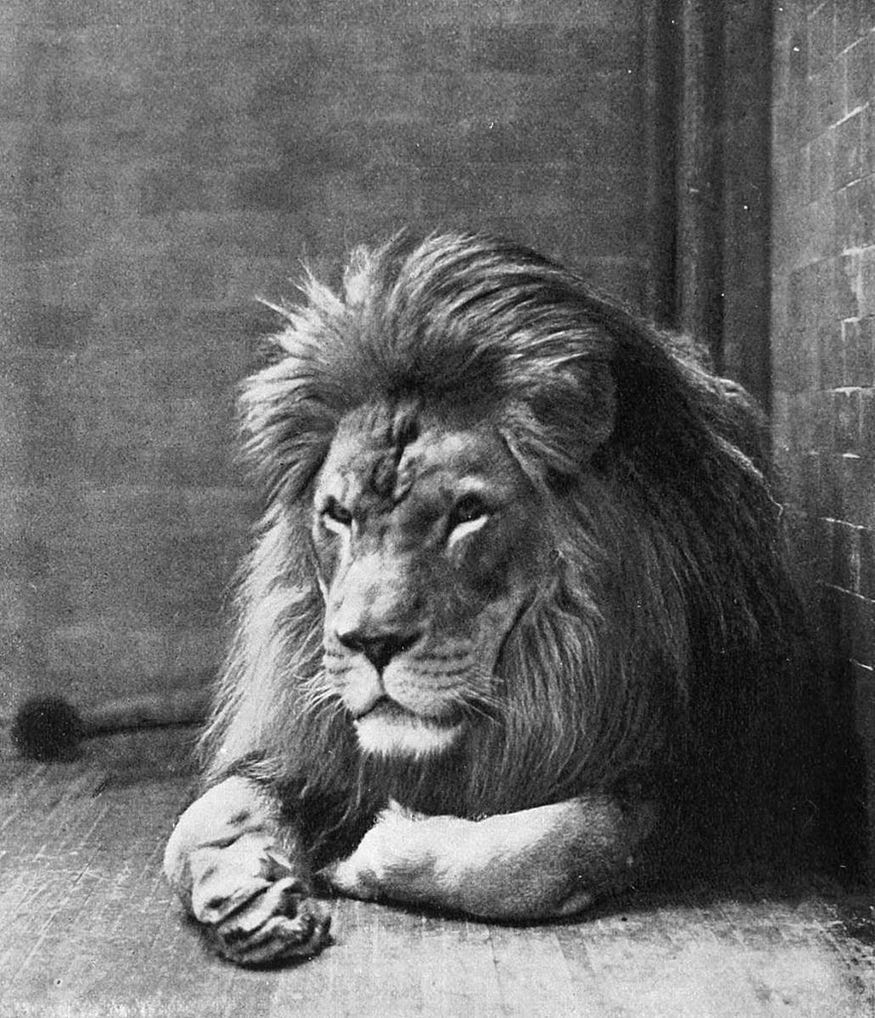Barbary Lions: A Natural History
A subspecies of lion that has inspired fascination and captured the imagination of many

Barbary Lions
The Barbary lion, a member of Panthera leo leo, has inspired amazement in humans for thousands of years. Though part of an extant subspecies, it’s considered a distinct subgroup due to its unique morphology and behavior, and is now gone from the wild.
The memorable characteristics of the Barbary lion, as well as its elusiveness, granted it a near-mythical status, creating an intense fascination with the majestic animal that often did it more harm than good.
Lion Evolution
The modern lion’s ancestors first evolved approximately 56–59 million years ago, in the Paleocene Epoch. These mammals, such as Dormaalocyon, were quite small, weighing in at less than one pound and reaching a length of 8–10 inches.
The Felidae family evolved around 25 million years ago and eventually split off into two subfamilies: Pantherinae (lions, leopards, tigers, jaguars) and Felinae (lynx, bobcats, mountain lions, pumas, cheetahs, domestic cats).
The genus Panthera made its first appearance in the fossil record about 3.8 million years ago (Pliocene Epoch).
Panthera leo fossilis, an early lion, was more muscular and smaller than the modern lion, and lived in Eurasia approximately 1.5 million years ago.
One of the most iconic prehistoric big cats is the cave lion (Panthera spelaea), which lived across Eurasia and northwestern North America during the Pleistocene Epoch and was prominently featured in Paleolithic art.
Cave lions had some notable characteristics that differentiated them from their relatives, including that the males didn’t have a mane. It also appears that they didn’t interbreed with other lion species.
Approximately 500,000 years ago, the lineages of the cave lion and modern lion diverged.
Another close relative of African lions is the American lion (Panthera leo atrox). It lived in North America from roughly 340,000 years ago until its extinction 10,000 years ago. American lions were among the largest felids ever to exist, coming in at up to 8 feet long and 800lbs, according to some estimates.
Barbary Lion History
Fossil evidence suggests that the Barbary lion evolved around 100,000 years ago in North Africa. These big cats inhabited the mountains, forests, and deserts of Egypt, Morocco, Tunisia, Libya, and Algeria.
The Barbary lion captured the imagination of Ancient Egyptians, appearing frequently in their artwork. In Egypt, the lion was considered symbolically significant, evoking power and guardianship, and was associated with Sekhmet, the lion-headed goddess of war and medicine.
Lion-headed amulets and figures dating back to the Iron Age have turned up during tomb excavations in places like the islands of Crete, Rhodes and Euboea.
Egyptian pharaohs were known to hunt Barbary lions and some, like Ramses II, are thought to have kept a few as pets.
The Nubian culture had a reverence for these lions and also regarded them as a powerful symbol, regularly representing them in their architecture and art.
Ancient Romans often used Barbary lions to fight gladiators in the Coliseum, and it’s estimated that thousands of the animals were killed during the reign of Caesar.
A combination of the rise of civilizations in North Africa and desertification is believed to have been largely responsible for causing lion populations to become more isolated in the region.
Barbary lions were also transported to Europe during the Middle Ages, where they were kept as popular attractions in places like the Tower of London’s menagerie. This was later proven when the DNA of two well-preserved skulls found at the Tower in 1936 and 1937 was tested. Radiocarbon dating of the skulls indicated that they came from around 1280–1385 and 1420–1480, respectively.
Additionally, lions had been gifted to the royal family of Morocco. However, when the family was exiled in 1953, these 21 big cats were transferred to two different zoos. A later analysis of mitochondrial DNA from a lion that had come from this collection would reveal that it was likely a descendant of the Barbary lion.
By the 19th century, Barbary lions were common attractions in circus menageries and hotels.
Behavior and Morphology
Barbary lions are regarded as a unique population among the Panthera leo leo subspecies, due to their distinct morphology and behavior. For example, the male generally had a thick and very dark mane that extended to his belly, as well as over his shoulders. The extra insulation was likely because they were adapted to live and thrive in the cooler parts of Africa, including the Atlas Mountains in the wintertime.
The manes of male zoological specimens range in color from light to dark tawny. Among these specimens, the males varied in size from 7.9 feet to 9.2 feet long, while the females averaged 8.2 feet in length.
Interestingly, a 20th century study conducted on lions in the Serengeti National Park showed that factors such as nutrition, ambient temperature and testosterone levels influence the color and size of the mane.
Historical accounts from hunters asserted that Barbary lions were the largest of all lions they encountered, claiming that they reached a size of up to 660 lbs and 10 feet long.
However, captive Barbary lions are known to have been smaller, at least in weight. But it’s unclear if this was an accurate reflection of their true size potential, as they were historically kept in poor conditions and probably malnourished.
Even before the animals became scarce in the wild, they were notably solitary by lion standards and were commonly observed either on their own or in small prides consisting of a male, female, and one or two cubs.
Other predators within their range included the Atlas bear and African leopard.
The Barbary lion’s diet consisted of animals like gazelles, red deer, oryx, wild boar, and, eventually, livestock.

Disappearance in the Wild
Their numbers dramatically decreased when firearms and lion bounties became more widespread across their range, and they were possibly already extirpated throughout much of the Mediterranean coast region by the 1830s.
The last photograph of a wild Barbary lion—a haunting aerial shot taken by Marcelin Flandrin in 1925—shows one wandering alone in the Atlas Mountains.
The last recorded shooting of one of these animals occurred in Morocco in 1942, and the final sighting of a wild Barbary lion that is regarded as legitimate took place in Algeria in 1956.
However, a study—which examined statistical data like sighting records and the average lifespan of these lions—estimated that Barbary lions might have existed in the wild until as late as the mid-1960s.
Are They Still Around?
It was a long-held belief that the Barbary lion was a unique subspecies of African lion. That is, until the findings of a genetic study were published in 2016, which revealed that they actually belong to the extant subspecies Panthera leo leo and are part of the same subclade as the Asiatic lion.
But, as previously mentioned, the Barbary lion is considered to be a distinct subgroup of P. l. leo that is extinct in the wild.
Yet while it’s no longer possible to encounter one in the wild, Barbary lions are not gone entirely and it’s estimated that there are still as many as 80–100 of these majestic animals in zoos across Europe and Morocco today.
If you would like to support my work and make a donation: Buy Me a Coffee
Additional Sources
G’s Data Lab, YouTube
Wild Ciencias, YouTube
Animalogic, YouTube
(This article was originally published on Owlcation)





